.
CONTENTS:
INSIDE THE FX OF:
|
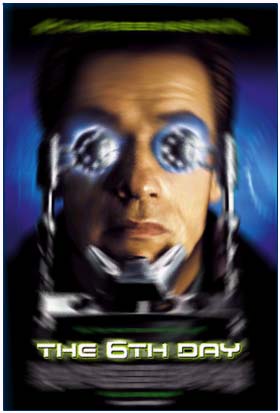 |
The 6th Day
In futuristic adventure "The 6th Day," from Sony Pictures', Arnold Schwarzenegger plays Adam Gibson, a man who soon discovers he has a clone. however, the cloning process is strictly forbidden, so assassins are sent to kill the clone. Only, the two Gibsons must work jointly to stop these assassins.
At first visual effects producer Karen Murphy thought the production would be a light assignment, with only about 200 visual effects shots -- "I thought I was taking a break," she said -- but those 200 shots became more like 700. "It more than tripled," she said. "That was a management challenge right there, having to gear up."
The production spent five months on location and on stages in Vancouver, Canada, which presented Murphy with an impending task to find the essential equipment and personnel. "We ended up having to fly our motion control people up there," she said. The situation may have been made worse by the number of shoots going on at the same time. By the time Murphy left Vancouver, there were 27 other productions in progression.
David Drzewiecki was the senior VFX supervisor on this film. Three prime facilities collaborated in the VFX duties: Cinesite, Visual Concepts Entertainment (VCE) and Rhythm & Hues. moreover, Seattle's Digital Kitchen created a "syncording" sequence showing how memories are inserted into a clone, and Germany's Film Bureau International produced five shots for a car chase. Michael Lantieri created on-set special effects, and Joe Viscocil blew up a one-eighth-scale building created by Gene Warren Jr. of Fantasy II.
"Dave Drzewiecki was the overall VFX supervisor, who supervised shooting. I supervised post effects," Murphy said. "That's happening a lot, where producers are scheduled to do double duty. These days, budgets are getting tighter."
Drzewiecki said "They were looking for someone who does what I do -- I'm a VFX supervisor, but I'm also a cinematographer." "When I came onto the project, it already had a momentum behind it," he said. Consequently, he needed to accommodate himself to a framework already laid out. "It's all about adaptation," he said.
Many effects in the film involve doubling Schwarzenegger. Cinesite did those. "We did some shots of Arnold looking at himself in the house," said Jerry Pooler, along with Tom Smith where Cinesite's in-house VFX supervisor. "We did a sequence in a hangar of the two Arnolds building a bomb that they take out one of the big buildings with."
"There's a shot where he actually punches himself," Smith speaking on Schwarzenegger said. "We had him act out the side of the character that gets hit first, then we played that back on a monitor." Using the image on the monitor for reference, Schwarzenegger was able to throw his punch in the right direction at the right time. "Then it was a matter of very carefully, over a number of frames, rotoscoping and making sure he got a good contact," Smith said. To help one character's fist land solidly on the other character's chin, Schwarzenegger's arm was lowered a little and morphed slightly in Elastic Reality. Cinesite also worked on the Talia and Drucker morph sequence where the clones develop before the viewers' eyes. Mark Lewis worked with Smith to get the right timing for the cut provided.
One more major Cinesite sequence convoluted producing a building replacement from a helicopter plate. "We were actually manipulating the Vancouver library," Smith said. The main building had to be raised up four stories, while another nearby was lowered, so that the overall scene would match a closer angle that had been shot on a different roof. "Technically, it was pretty challenging," Smith said. "There were a lot of tracking issues, because the perspective changed. Lynn Basas and Tim Gibbons put in a lot of time to make the shot work."
Cinesite also enhanced the inside of a futuristic shopping mall, creating a 3D people mover and holographic advertisements and adding ceiling enhancements of 3D clouds and underwater fish plates. "We wanted to do something special with the ceiling," Smith said. "Lubo Hristov came up with some really nice concepts. We just played a little bit on that theme."
"We did a lot of 3D," Pooler said. "I come from a 2D world. I'm used to having the elements, finessing them and moving on. When I have to go to 3D, I have to remember to slow down. In a 3D situation, everything takes longer."
In all, Cinesite produced approximately 325 shots, rather than the 40 they originally signed on to do. For work in 3D, such as the mall train and the building replacement, Cinesite used Alias|Wavefront's Maya. Compositing was done in Cineon and tracking in 3D Equalizer.
VCE was responsible for roughly 230 shots, including the virtual girlfriend of Schwarzenegger's character and the foosh guns the characters in the movie use to shoot at each other.
VCE founder Peter Kuran said the company won the assignment based on a virtual-girlfriend test done before production. Given footage of actress Jennifer Gareis -- one shot in which she wears a red dress, the other with the performer in her underwear -- Kuran combined the two to create a scene in which the virtual girlfriend morphs from fully clothed into her lingerie. "The director thought that was unique," Kuran said.
During the actual production, the actress was shot against greenscreen, repeating a scene just played with Schwarzenegger. "The trick was to stay with production," Kuran said. As soon as the scene with Schwarzenegger was finished on the main set, someone would run the motion control disk to the greenscreen stage down the street so that the actress could repeat the scene. "We basically had to re-create any takes the director wanted to use," Kuran said. "Whatever he was trying to do, we would have to quickly reproduce them, to have the same spontaneity." Afterward, when the scene was put together, a certain amount of distortion was added, to give the woman's holographic figure more dimension. "We created 3D distortion to sort of mold the background through," Kuran said.
The foosh gun blasts were done mainly in After Effects. For the most part, VCE uses Macs and PCs running programs such as After Effects and LightWave, which might be considered low end. To Kuran, though, that is an advantage. "The low-end tools, because they are exposed to so many people, actually evolve faster, because the low-end tools get a lot of user feedback," he said.
He also used a small crew, despite the large number of shots. "Our crew was actually 10 people," Kuran said. "I try to keep the crew small and be as productive as possible."
Most of the 183 shots that Rhythm & Hues bequeathed to the film involve the Whispercraft, a helicopter that Schwarzenegger's character flies in the movie. "It was a completely CG helicopter that had the ability to transform itself from a helicopter to jet propulsion," said Tom Leeser, visual effects supervisor and art director at R&H.
VFX producer Murphy said that director Roger Spottiswoode had seen footage of fully digital airplanes from "Pushing Tin" on the R&H reel, and that was what made him want a digital Whispercraft. The challenge was for computer graphics to simulate an object audiences are used to seeing in real life. While the Whispercraft is a more futuristic version of a helicopter, viewers can still compare it to the other helicopters they've seen. "It wasn't necessarily so in the future that you would be able to get away with certain unbelievable things," Leeser said. "It didn't do anything outside of our world. It just did it better."
To help himself understand the theory behind the Whispercraft technology, Leeser did a lot of research on how helicopters move. "What we wanted to do was push the limits of what was physically possible. Spottiswoode had done a lot of flying himself, so he brought along his personal experience. He wanted something that would take the audience beyond reality."
In the course of the film, the Whispercraft appears in full daylight, which made the 3D work that much more complex to achieve, with no place to conceal mistakes. "One of the biggest challenges was to create photo-realistic imagery right in your face," Murphy said.
In one tough sequence, with backgrounds shot in an area just north of Vancouver, the characters played by Schwarzenegger and Michael Rapaport fly through canyons in the Whispercraft in broad daylight. "It introduces the Whispercraft in terms of its transformation capabilities," Leeser said. The craft was created using proprietary Rhythm & Hues 3D software, with Silicon Grail's Chalice used for compositing.
Digital Kitchen in Seattle did about 60 shots, including the main title montage and sequences in which memories are implanted into clones. "The main title sequence shows the collision of events that led up to the whole plotline," said Paul Matthaeus, chief creative officer of Digital Kitchen. "It starts with the ability of science to read DNA and to clone." At that point, Digital Kitchen wanted a way to convey a churning biological activity. "We developed this look," he said. "It's a computer animation that we dubbed 'bio-schmutz.'" This then expands into less microscopic images, ranging from embryos to sheep, like Dolly, the famous cloned Scottish sheep. At the point when the prologue implies that science has cracked the equation to cloning humans, protesting erupts. "Certain things being done at a sub-cell level reverberate out into society," Matthaeus said. Digital Kitchen, which specializes in TV spots and marketing, was also faced with the challenge of designing a look for the way memories might appear if they were captured in the computer and then transplanted into another mind. The entire staff of 12 people worked on the project, using images from the movie itself, stock footage and photos as well as some material created in-house and assembling it all into the visual collage that Spottiswoode wanted.
VFX editor Drake, who helped supervise effects during post-production, said the movie was a hard one. "I think the biggest challenge was the number of the shots and the time we had to do them in," Drake said. Toward the end, 600 shots had to be done in about 16 weeks, he recalled. "The biggest problem with movies these days is that there's not enough time. Unfortunately, something has to give, and it's usually the budget."
Senior VFX supervisor Drzewiecki said that, stylistically, this film was approached as if there were no visual effects. This may have freed it from what he feels pulls down many effects-heavy movies, in which every shot is intended to elicit a "wow" from the audience. "I don't really feel that this was a 'wow' shot movie," Drzewiecki said. "We weren't doing shots for the sake of doing shots."
Visual Concept Entertainment
vce.com provides over 230 visual effects shots for "The Sixth Day" including the audience-pleasing "virtual girlfriend." From pre visualization and supervision in Vancouver to finishing in Los Angeles.
|
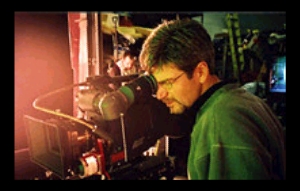 |
Dave Drezweicki lines up a shot of the virtual girl on the green screen effects unit located a block from the location of "Hank's Condo."
|
Pete Kuran works on the green screen set up with Dave Drezweicki for the virtual girl sequence. Joe Lewis and General Lift provided the genuflex motion control system used to encode and play back the camera moves for the virtual girl photography.
|
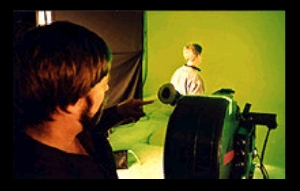 |
 |
Action is called as Jennifer Gareis, the virtual girl, acts to an already photographed Hank (Michael Rapaport) and Adam Gibson (Arnold Schwarzenegger).
|
 |
Beneath her feet is a plexiglass mirror to catch the reflection of the green screen material. She was placed on a rotating disk to get her motions more ethereal.
|
After production is completed and the scenes are edited, Kurt Wiley works on the virtual girl digital design and compositing. Kurt also provided Pre-Visualization up in Vancouver during production.
|
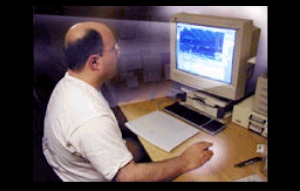 |
 |
 |
 |
In the finished shot, the virtual girl, sitting on Hanks lap is distracted by the knocking on the door.
|
In this over the shoulder shot of Hank, you can see the distortions present for virtual girl to give her more depth.
|
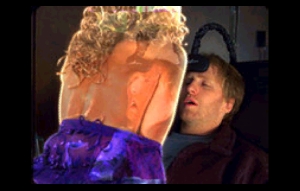 |
 |
NAVIGATION